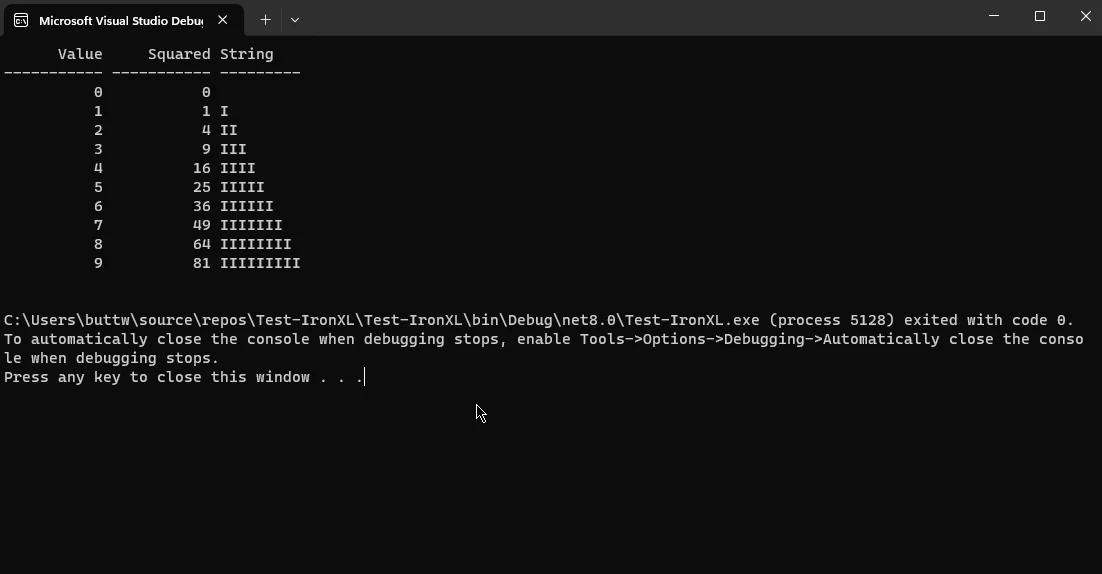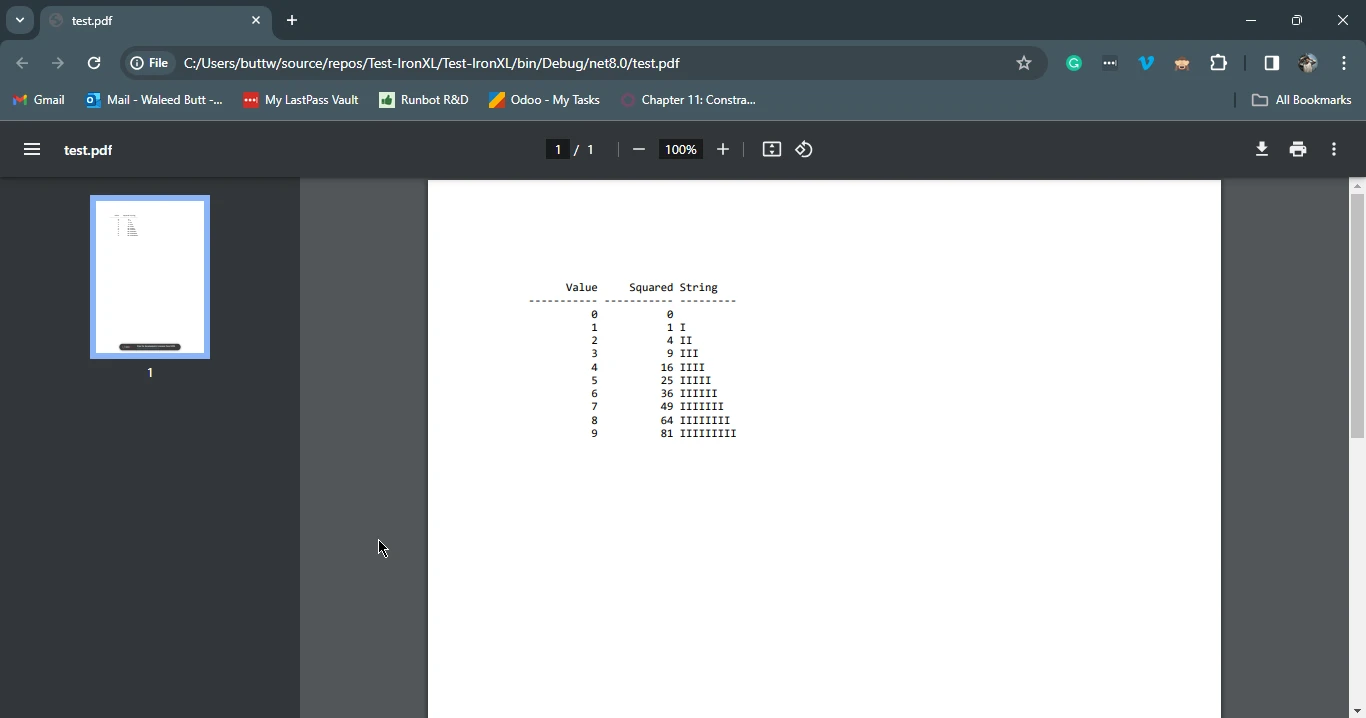Test in a live environment
Test in production without watermarks.
Works wherever you need it to.
Testing plays a pivotal role in the realm of software development, serving to function as a crucial element in guaranteeing the quality of applications. Among the plethora of frameworks available, .NET stands out as a widely embraced choice for crafting Windows-based applications. This article delves into the intricacies of .NET TestConsole, a tool specifically designed for testing .NET applications.
Throughout this exploration, we will write a comprehensive code example illustrating the practical implementation of .NET TestConsole. Additionally, we will shed light on IronPDF, an exemplary C# PDF library seamlessly integrated with .NET TestConsole. This library proves to be invaluable, empowering developers to effortlessly access and generate PDFs within the .NET TestConsole environment. Join us on this journey as we unravel the functionalities and possibilities that arise from the synergy of .NET TestConsole and IronPDF.
TestConsole is a versatile testing library that introduces a distinctive approach to unit tests in the C# programming language. Traditional methods of unit tests often face challenges when dealing with large datasets and complex assertions, leading to difficulties in identifying differences between expected and actual results. In response to this, Test Console provides a novel workflow, shifting from the conventional prediction-based approach to a side-by-side comparison of formatted output with a designated "approved" standard output version.
In this library, particularly with the TestConsole, the '.Core' variant extends the formatting capabilities inherited from the original TestConsole project and incorporates essential test approval features in scenarios where test results diverge from expectations. TestConsole.Core seamlessly integrates with the build server to trigger a test failure. On the development PC, by default, it offers reconfigurability to utilize installed file compare utilities for visualizing differences. Notably, this approach streamlines the approval process, allowing developers to update the approved version manually if differences are expected.
TestConsole.Core draws inspiration from ApprovalTests but distinguishes itself by providing support for writing both a full framework and .NET Core test suites. The library addresses the need for testing in diverse environments, as with ApprovalTests at the time of publication, primarily catered to full framework scenarios. The syntax in TestConsole.Core, while sharing similarities with ApprovalTests, offers distinctions, especially concerning file compare tool selection and direct approval of content.
Developed to facilitate testing in .NET Core app code, TestConsole.Core arises from the necessity to bridge the gap left by the lack of .NET standard and .NET Core app support in ApprovalTests. With a focus on enabling effective testing of large datasets, TestConsole.Core's test approval features accommodate data formatted using the Test Console Output object and extend their functionality to handle any plain text input, providing a comprehensive solution for unit testing in C#.
The test console can be installed using the NuGet package Manager form inside Visual Studio, or by running the following command in the NuGet package manager Console.
Install-Package TestConsole -Version 2.6.0Or download directly using from TestCosole NuGet Page.
In this section, we will see how you can convert console outputs to reports. the below source code uses a test console to convert Enumerable objects into a well-formatted report table
using TestConsoleLib;
var output = new Output();
var data = Enumerable.Range(0, 10)
.Select(i => new { Value = i, Squared = i * i, String = new string('I', i) });
output.FormatTable(data);
string report = output.Report;
Console.WriteLine(report);using TestConsoleLib;
var output = new Output();
var data = Enumerable.Range(0, 10)
.Select(i => new { Value = i, Squared = i * i, String = new string('I', i) });
output.FormatTable(data);
string report = output.Report;
Console.WriteLine(report);Imports TestConsoleLib
Private output = New Output()
Private data = Enumerable.Range(0, 10).Select(Function(i) New With {
Key .Value = i,
Key .Squared = i * i,
Key .String = New String("I"c, i)
})
output.FormatTable(data)
Dim report As String = output.Report
Console.WriteLine(report)This C# code snippet utilizes the TestConsoleLib library to demonstrate and run a simple example of formatting and reporting tabular data using TestConsole's Output class. It begins by creating an instance of the Output class named 'output.' Subsequently, it generates a collection of 10 elements containing anonymous objects with properties representing an integer value, its square, and a string of 'I's whose length corresponds to the integer value.
The output.FormatTable() method is then invoked to format the data into a table. The formatted result is stored in the 'report' string variable, which is finally printed to the console using Console.WriteLine(). This showcases TestConsole's capability and ability to easily format and present tabular data for improved readability during unit testing or debugging scenarios.

IronPDF is a powerful C# library designed to simplify and enhance the process of working with PDF documents in .NET applications. Offering a comprehensive set of features, IronPDF empowers developers to effortlessly create, manipulate, and extract content from PDF files within their C# projects. With a focus on flexibility and ease of use, IronPDF supports a wide range of functionalities, including the generation of PDFs from HTML, images, or existing documents, as well as the incorporation of dynamic content, such as charts and tables.
Its capabilities extend to the merging, splitting, and manipulation of PDF pages, as well as functions such as the extraction of text and images. Whether for reporting, documentation, or any PDF-related task, IronPDF stands out as a reliable and versatile solution, streamlining the integration of PDF functionality into C# applications with minimal effort.
In this section, we will discuss how you can convert the output from TestConsole reports.

Install-Package IronPdf
To Integrate IronPDF into your Console project using the NuGet Package manager, follow these steps:
If you want to include IronPDF in your project via Package manager console, then execute the following command in Package Manager Console:
Install-Package IronPdfIt’ll fetch and install IronPDF into your project.
For a detailed overview of IronPDF, including its features, compatibility, and additional download options, visit the IronPDF page on the NuGet website at https://www.nuget.org/packages/IronPdf.
Alternatively, you can incorporate IronPDF directly into your project using its dll file. Download the ZIP file containing the DLL from this link. Unzip it, and include the DLL in your project.
Once installed now we will recreate the above example report but this time instead of writing it into the console, we will create a PDF report from it.
using TestConsole.OutputFormatting;
using TestConsoleLib;
using IronPdf;
var output = new Output();
var data = Enumerable.Range(0, 10)
.Select(i => new { Value = i, Squared = i * i, String = new string('I', i) });
output.FormatTable(data);
string report = output.Report;
var htmlContent = $"<pre>{report}</pre>";
var renderer = new ChromePdfRenderer();
var pdf = renderer.RenderHtmlAsPdf(htmlContent);
pdf.SaveAs("test.pdf");using TestConsole.OutputFormatting;
using TestConsoleLib;
using IronPdf;
var output = new Output();
var data = Enumerable.Range(0, 10)
.Select(i => new { Value = i, Squared = i * i, String = new string('I', i) });
output.FormatTable(data);
string report = output.Report;
var htmlContent = $"<pre>{report}</pre>";
var renderer = new ChromePdfRenderer();
var pdf = renderer.RenderHtmlAsPdf(htmlContent);
pdf.SaveAs("test.pdf");Imports TestConsole.OutputFormatting
Imports TestConsoleLib
Imports IronPdf
Private output = New Output()
Private data = Enumerable.Range(0, 10).Select(Function(i) New With {
Key .Value = i,
Key .Squared = i * i,
Key .String = New String("I"c, i)
})
output.FormatTable(data)
Dim report As String = output.Report
Dim htmlContent = $"<pre>{report}</pre>"
Dim renderer = New ChromePdfRenderer()
Dim pdf = renderer.RenderHtmlAsPdf(htmlContent)
pdf.SaveAs("test.pdf")This C# code snippet showcases the integration of TestConsoleLib and IronPDF to generate a PDF document containing a formatted table of data. Initially, it creates an instance of the Output class from TestConsoleLib and formats a table using data generated from a range of integers. The formatted output is stored in the 'report' string variable, which is then enclosed within HTML pre-tags to preserve the formatting.
Subsequently, the code utilizes the ChromePdfRenderer from IronPDF to render the HTML content as a PDF document. Finally, the resulting PDF is saved as "test.pdf." This code demonstrates the seamless combination of TestConsoleLib for formatting and IronPDF for PDF generation, providing a straightforward solution for incorporating formatted data into PDF documents within a C# application.

The .NET TestConsole emerges as a pivotal testing library for C# applications, presenting a distinctive approach to unit testing that alleviates challenges associated with large datasets and complex assertions. The TestConsole.Core variant extends its utility across diverse environments, bridging gaps left by other frameworks and providing an efficient workflow for side-by-side comparisons of formatted outputs.
It integrates seamlessly with IronPDF, a robust C# library, and not only facilitates streamlined testing but also extends its capabilities to PDF generation and manipulation. Together, these tools empower developers to effortlessly handle testing intricacies and enhance document generation in their C# projects, offering a comprehensive and efficient solution.
The detailed and complete tutorial on IronPDF HTML to PDF conversion can be found here.
9 .NET API products for your office documents








